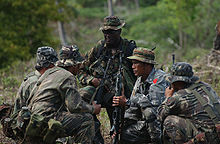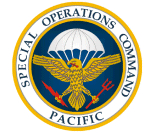United States Special Operations Command Pacific
The Special Operations Command Pacific (SOCPAC) is a Sub Unified Combatant Command that unites and leads the Special Operations Forces of the United States Indo-Pacific Command (INDOPACOM). It is stationed at Camp HM Smith on the island of Oahu in the US state of Hawaii . The area of responsibility of PACOM and thus also of SOCPAC comprises over half of the earth's surface with an area of over 100 million square miles and 60% of the world's population.
assignment
The SOCPAC is tasked with operationally leading all the special forces of the four armed forces, ensuring their operational readiness by planning and executing appropriate maneuvers , developing, determining and optimizing the target setting, as well as the cooperation and implementation of joint exercises with special forces of allied and friendly countries promote and vote.
In addition, the command is responsible for the military fight against terrorism , which it also coordinates with the allies and sometimes carries out jointly. For this task, SOCPAC has a permanent alarm force ready for the PACOM commander and at the same time forms a tactical reserve within the regional command with its special forces.
In addition to the classic military fields of action, SOCPAC is also responsible for carrying out and coordinating the fight against drugs . The command works with other federal authorities such as the Drug Enforcement Administration (DEA) and the Central Intelligence Agency (CIA) as well as with national military and law enforcement authorities in the host countries.
The Commander, Special Operations Command, Pacific (commander of SOCPAC ) also acts as the commanding officer of Joint Task Force 510 , the permanent rapid reaction force of the PACOM.
organization
The following associations are currently subordinate to SOCPAC :
- Joint Task Force 510 (JTF-510) : The JTF-510 forms the permanent alarm component of the PACOM, whose core forces are provided by the SOCPAC . It is not only a military component of operations, but is also constantly available for military and security advice, humanitarian aid missions and evacuation measures in the entire operational area (area of responsibility). In an emergency, the JTF-510 will probably always be the first unit at the scene of the crisis. If their forces are not sufficient to control the situation, they can request other larger units, e.g. B. the 31st Marine Expeditionary Unit from Okinawa ( Japan ).
As a group command, SOCPAC leads all special operations units of all branches of the Pacific Command (PACOM), these are composed of the following components:
- The Army Special Operations Command is doing naturally the largest contingent with the 1st Special Forces Group of the Green Berets , an association in brigade strength , but has only one man strength of about 1,400 soldiers due to its special structure. Its 1st Battalion is stationed at Torii Station on Okinawa (Japan). His main tasks consist of joint exercises with allied armed forces and the provision of preparedness forces for rapid crisis response in his area of responsibility in Southeast Asia and the Pacific region. The 2nd and 3rd Battalions are stationed in Fort Lewis , Washington State , and can be made available to the PACOM commander at any time if necessary. Parts of the 3rd Battalion are constantly involved in the fight against drugs in Thailand .
- The Naval Special Warfare Command (NAVSOC) the Navy has the SOCPAC an unknown ( secret ) number of Navy Seals and Special Boat Units assumed. The majority of the Navy's special forces are concentrated in the Naval Special Warfare Task Unit-Pacific , including a SEAL platoon reporting to it at Apra Harbor Naval Station on the island of Guam .
- The Air Force Special Operations Command provides the Air Force component of the SOCPAC with the 353rd Special Operations Group . It also reports to units of the Special Tactics Squadrons , Pararescue jumpers for Combat Search and Rescue and Search and Rescue missions.
- It is not known which units and in what strength troops of the recently established Marine Corps Forces Special Operations Command (MARSOC) of the Marines are subordinate to the SOCPAC .
history
The forerunner of SOCPAC , the Special Operations Center, Pacific Command (center for special operations of the Pacific Command ) was established on November 1, 1965 on Okinawa and was responsible for the unconventional warfare in the Southeast Asian area of the PACOM. On July 1, 1969, this facility was dissolved and its functions were assigned to subordinate command levels of the PACOM. In the mid-1970s it became clear that a separate planning facility for special forces was needed, so on May 15, 1976, a corresponding section was set up within the PACOM operations department.
In October 1983, the United Chiefs of Staff ordered the establishment of an independent Special Operations Command (command for special operations) as a subordinate command facility of the PACOM with a staff of initially 18 men, thus the core structure of the SOCPAC was established.
On November 18, 1989, SOCPAC took command of the Air Force's 353rd Special Operations Group , based at Kadena Air Base , Okinawa, Japan. On July 8, 1991, the Naval Special Warfare Task Unit-Pacific and a SEAL-Platoon were in command at Apra Harbor Naval Station (Guam). Thus, the SOCPAC developed for the first time into a group command that leads components of various branches of the armed forces.
SOCPAC units regularly take part in international maneuvers throughout the Pacific and Southeast Asian regions, with the aim of maintaining their own level of training, promoting and developing international military cooperation and joint operational capabilities. At the same time, the political ties of the United States with its allies and friendly nations are to be documented to the outside world. Parts of the JTF 510 are regularly involved in numerous military exchange programs with over 20 countries. The SOCPAC annually organizes the Pacific Area Special Operations Conference (PASOC) , a symposium on unconventional warfare that takes place in Hawaii. This conference is regularly attended by delegates from over 25 countries including the highest ranks of general and admiral .

In addition to its military tasks, the command is also heavily involved in the fight against drugs, especially in Thailand, Laos , Cambodia and the Philippines .
A number of contingents are constantly carrying out mine clearance operations in Indonesia , East Timor and the Philippines, which are constantly being re-established as a result of national conflicts.
The Pacific Southeast Asian region has traditionally been of particular interest to the United States. Both economically and politically. The overall economic growth rate in this region is more than twice that of the rest of the world. This development is accompanied by a corresponding modernization of the individual local armed forces, which is a constant challenge for the USA as the dominant hegemonic power, especially when one takes into account that the six largest armies in the world operate in this region. In addition, the military situation is complicated by the fact that a number of countries would be able to manufacture weapons of mass destruction if they lost confidence in the United States as a protective nuclear power.
Politically, due to its size with its 43 nations, 75 languages and 20 different religions, there are regularly smoldering trouble spots in the region, with the Korean peninsula, the Kashmir conflict and the underground movements in Indonesia being a particular focus of SOCPAC .
The central element of the SOCPAC strategy is military and security advice. It is intended to bind the target nations to the United States through training, equipment and humanitarian measures on the one hand, and to stabilize the governments of these countries on the other hand and enable them to later reproduce the know-how they have learned. This is being done as an accompanying military measure in US foreign policy. International maneuvers and multilateral military units flank these missions.
In 1998 the Pacific Situation Assessment Team (PSAT) was set up to coordinate the military and security advisory activities of the SOCPAC and coordinate them with the State Department .
In 1999 SOCPAC carried out a total of 37 individual deployments in 12 countries.
In January 2002, after the terrorist attacks of September 11, 2001 , SOCPAC moved parts of the JTF 510 to the Philippines in order to carry out anti-terrorism operations with forces there as part of Operation Enduring Freedom . These lasted until September 1st of the same year. This was followed by a training unit that, together with the Philippine military, set up and formed the Joint Special Operations Task Force-Philippines and, together with the new unit, continued the fight against terrorist elements.
management
Rear Adm. P. Gardner Howe III currently heads SOCPAC. His deputy has been Col. Bob G. Bond since July 2012 .
Others
The nickname of the Special Operations Command Pacific is "Guardians of the Pacific" ( Guardians of the Pacific ).
References
Web links
- Official website of SOCPAC (English)
- Official 2009 SOCOM Factbook (pdf), p. 40 ( Memento of March 24, 2009 in the Internet Archive ) (English; 4.29 MB)
- SOCPAC at pacom.mil ( Memento from August 31, 2003 in the Internet Archive ) (English)
- The SOCPAC at globalsecurity.org (English)
Individual evidence
- ↑ [...] area of responsibility encompassing over 100 million square miles of the Asia-Pacific and Indian Ocean regions. [...] see pacom.mil ( memento of the original from June 6, 2013 in the Internet Archive ) Info: The archive link was inserted automatically and not yet checked. Please check the original and archive link according to the instructions and then remove this notice. (accessed November 20, 2013)
- ↑ The six largest armed forces in the world operate in the Pacific AOR at globalsecurity.org (accessed May 10, 2008)
- ↑ The 43 nations, 20 territories, and 10 US territories represent 75 official languages and over 20 distinct religions at globalsecurity.org (accessed May 10, 2008)
- ↑ Commander. (No longer available online.) SOCPAC, archived from the original on October 11, 2013 ; accessed on November 20, 2013 (eng.). Info: The archive link was inserted automatically and has not yet been checked. Please check the original and archive link according to the instructions and then remove this notice.
- ↑ Deputy Commander. (No longer available online.) SOCPAC, archived from the original on October 11, 2013 ; accessed on November 20, 2013 (eng.). Info: The archive link was inserted automatically and has not yet been checked. Please check the original and archive link according to the instructions and then remove this notice.


